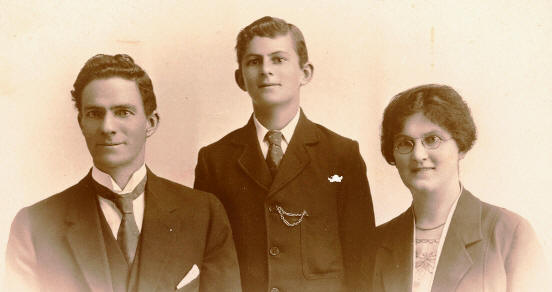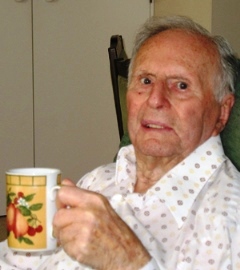william henry mallindine + emma cecilia hosken
William was born in Auckland, New Zealand on 19 December 1884 to William Mallindine and Elizabeth Emma Scammell. His family had emigrated from Bethnal Green in the East End of London several years before and he was the first Mallindine to be born in New Zealand. They left Auckland when William was two and settled in Ngaruawahia near Hamilton where they remained for fifteen years before one final move to Whangarei.

William married Emma Cecilia Hosken in Whangarei on 10 February 1909 and their only son, William Trevor, was born nine months later on 24 November. Emma was born in Gundagai, New South Wales in Australia on 1 December 1887 to Joseph Hosken and Emma Tippett.
William was working as a cabinet maker for Harrison & Son in Whangerai when he enlisted as a Sergeant Major in the 1st battalion of the Wellington Infantry Regiment on 11 Jan 1916. He left New Zealand in September and joined his regiment at Etaples, a port city between Calais and Dieppe, on 14 October. Two months later, the Northern Advocate newspaper reprinted a letter from William to Major Clark-Walker in New Zealand recounting his first few weeks in France:
Just a few lines to let you know I am not yet pushing up the daisies, and am keeping fit. I am having a few days off this week with a poisoned hand. I cut it opening a ‘bully’ tin. The cut healed up all right but a couple of days back it started to fester underneath and has given me ‘jipo’ ever since. I am doing a bit of orderly-room work just now to give the wound a chance to heal up.
Well Major, I have travelled a few miles and seen some things since I last saw you, and I hardly know where to start this letter, to give you the news. However, I will start at Plymouth, where we landed off the boat and from Plymouth we went straight to Sling Camp near Salisbury. We put in abour four weeks there in training. My impressions of the journey from Plymouth to Sling were like travelling through a huge park; the trees and fields looked so beautiful and green, especially after being on the water so long. I managed to get up to London before coming over here. It’s a wonderful city. I had a look at some of the principal places, and saw as much as I could in the time that I had at my disposal. I am looking forward to having another look round before I come back to New Zealand. From Sling camp we were sent to another training camp in France for about a fortnight, and then we went on to the trenches.
Things were fairly quiet on our bit of front during our stay there. Fritz used to send over a few shells, bombs, etc. and his aeroplance would drop a bomb or two on us occasionally; but it’s surprising how soon one gets used to a few shells dropping round. The grenades are the most dangerous, as one cannot hear them coming, especially the ones that burst with concussion. They don’t give a chap much time to hop out of the way, and the old hands tell me that it gives a man a nasty pain in the ‘tummy’ when a grenade goes off close by.
I have seen quite a number of aerial bombardments lately and it is a grand sight on a fine day. Of course, it’s not much sport for the airmen, although they very seldom get hit. One afternoon I saw the Germans put up about 400 shells at one of our machines and never got any near. I think it’s more by luck than judgment when they get a hit, as the target is so small and constantly moving two ways at once – elevation and direction. I have seen the aeroplanes so high that they have looked no larger than what we call a horse stinger fly in New Zealand.
We are out of the trenches just now for a bit of a spell. The weather is getting bad – cold and wet – and the mud is up to our boot-tops, with every prospect of it being up to our knees before long. The country round about here is very flat and the water does not get away very fast. I saw Dr. Campbell, Kean Clark, Sid Wrack and several other North Auckland boys at Etaples. Dr Good was wounded and went back to England. The Rev. Cruickshank is over here but I haven’t seen him since I came to France. Major Mackesy is still in England, waiting to get away. Give my kind regards to all the boys.
William’s health suffered from life on the front and he was evacuated from the trenches on several occasions with severe vomiting and diarrhea as well as bouts of asthma and bronchities. On 1 February 1918, he was admitted to the New Zealand General Hospital in Brockenhurst, Hampshire suffering from dysentary and two months later he was discharged for health reasons after appearing before a Medical Board. He served in France and England for 1 year and 263 days before returning home to New Zealand.
William returned to Whangerai and resumed his work as a Cabinet Maker. The family was living on Second Avenue in 1919 but move to Bank Street where they remained for the next twenty years. William died in Auckland on 29 October 1962 and Emma died in Whangerai in 1970.

Their son, known as Trevor, was working as a Draper when he married Grace Maud Watt in 1932. Grace worked as a Teacher and was later appointed the Assistant School Mistress for the Whau Valley School in Whangerai by the Auckland Education Board. Trevor and Grace had one daughter born in 1941 but five years later, Grace died and was buried in the Papakura Old Cemetery in Auckland.
The following year, Trevor married again to Winnifred Johns Harris and they had two sons. They left Whangerai and settled in Whangaparaoa, a seaside town about 25 kms north of Auckland where Trevor worked as a shopkeeper and grocer. Winnifred died at the North Shore Hospice in Whangaparaoa on 14 December 2002 at the age of seventy-eight.
Trevor married a third time to Ruth Aburn in 2004 but she died two years later and was buried in her family plot at the Archer Street Masterton Cemetery in Wellington. Trevor spent his last years in Red Beach near Whangaparaoa and lived to celebrate his 101st birthday. He died on 16 December 2010 at the Northaven Hospital in Whangaparaoa.